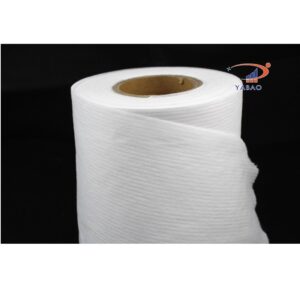The texture of PP (polypropylene) spunbond nonwoven fabric differs from that of woven or knitted fabrics due to the way it is manufactured:
- PP Spunbond Nonwoven Fabric: PP spunbond nonwoven fabric has a unique texture characterized by a uniform and smooth surface. It is produced by extruding and stretching polypropylene fibers, then bonding them together using heat and pressure or chemical processes. The resulting fabric has a consistent texture without distinct weave patterns or loops typical of woven or knitted fabrics. PP spunbond nonwoven fabric tends to have a slightly papery or plastic-like feel, depending on its density and surface treatment.
- Woven Fabrics: Woven fabrics are constructed by interlacing yarns (warp and weft) at right angles to create a stable structure with visible weave patterns. The texture of woven fabrics can vary depending on factors such as the type of yarn, weave pattern, and finishing treatments. Woven fabrics often have a tactile texture with raised areas where yarns intersect and a smooth surface between the yarns.
- Knitted Fabrics: Knitted fabrics are produced by interlocking loops of yarn to create a stretchable and flexible structure. pp spunbond nonwoven fabric The texture of knitted fabrics is characterized by a series of loops that can vary in size and density depending on the knitting technique used. Knitted fabrics have a softer and more elastic texture compared to woven fabrics, with a slightly bumpy surface formed by the loops of yarn.
In summary, PP spunbond nonwoven fabric has a smooth and uniform texture without distinct weave patterns or loops, unlike woven or knitted fabrics. Its texture is often described as papery or plastic-like, making it suitable for a wide range of applications where a smooth and consistent surface is desired.
What are some potential uses of pp spunbond nonwoven fabric in the fashion industry?
PP (polypropylene) spunbond nonwoven fabric has several potential uses in the fashion industry, offering unique properties and versatility for various applications. Here are some potential uses:
- Apparel Interfacing: PP spunbond nonwoven fabric can be used as interfacing material in garments to provide structure, stability, and support. It is commonly used in collars, cuffs, waistbands, and other areas that require reinforcement. PP spunbond nonwoven interfacing is lightweight, durable, and easy to sew, making it ideal for adding shape and body to garments without adding bulk.
- Lining Material: PP spunbond nonwoven fabric can be used as a lining material in garments to improve comfort, insulation, and moisture-wicking properties. It is often used in jackets, coats, and outerwear to provide an additional layer of protection against the elements. PP spunbond nonwoven lining is breathable, hypoallergenic, and resistant to mold and mildew, making it suitable for a wide range of clothing applications.
- Accessory Production: PP spunbond nonwoven fabric can be used to produce fashion accessories such as bags, hats, belts, and scarves. It is lightweight, water-resistant, and easy to manipulate, making it suitable for creating various accessory designs. PP spunbond nonwoven accessories can be customized with prints, textures, and embellishments to add visual interest and style.
- Footwear Components: PP spunbond nonwoven fabric can be used to manufacture footwear components such as insoles, linings, and reinforcements. It provides cushioning, support, and breathability for enhanced comfort and performance. PP spunbond nonwoven footwear components are lightweight, durable, and resistant to abrasion and moisture, making them suitable for athletic shoes, sandals, and casual footwear.
- Fashion Prototyping: PP spunbond nonwoven fabric can be used in the fashion design process for prototyping and pattern development. It is an inexpensive and readily available material that allows designers to experiment with shapes, draping, and construction techniques before finalizing designs in more expensive fabrics. PP spunbond nonwoven fabric can also be used for runway shows, photo shoots, and presentations to showcase conceptual ideas and creative concepts.
Overall, PP spunbond nonwoven fabric offers numerous opportunities for innovation and creativity in the fashion industry, providing designers with a versatile and sustainable material for a wide range of applications. Its lightweight, durable, and customizable properties make it an attractive choice for fashion designers looking to explore new possibilities in garment construction and accessory design.
